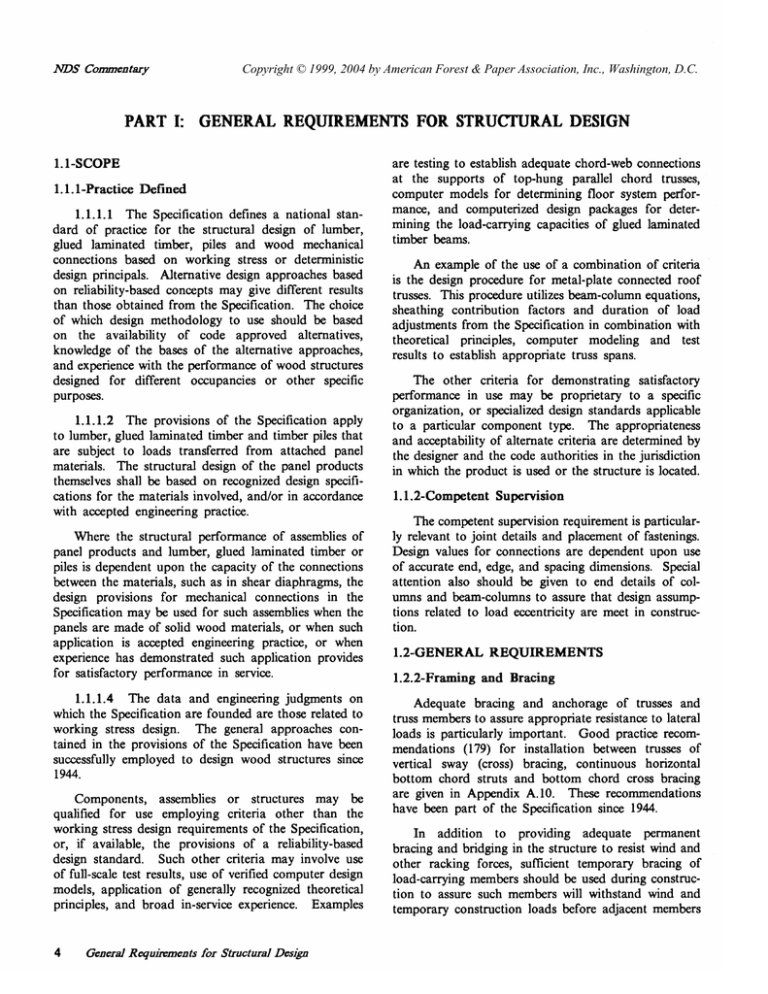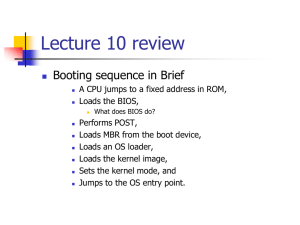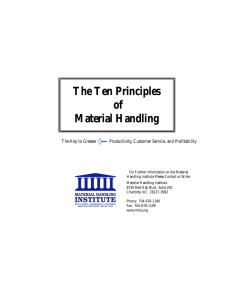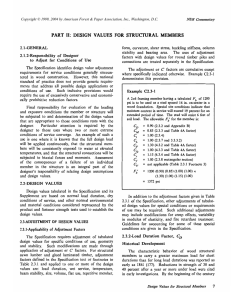PART I: GENERAL REQUIREMENTS FOR ... DESIGN
advertisement

NDS Comentary Copyright © 1999, 2004 by American Forest & Paper Association, Inc., Washington, D.C. PART I: GENERAL REQUIREMENTSFORSTRUCTURAL 1.1-SCOPE 1.1.1-Practice Defined 1.1.1.1 The Specificationdefinesa national standard ofpractice for the structural designof lumber, glued laminated timber, piles and woodmechanical connectionsbased on working stress or deterministic designprincipals. Alternative design approaches based on reliability-based concepts may givedifferentresults than those obtained from the Specification. The choice ofwhichdesign methodology to use should bebased on the availability of code approved alternatives, knowledgeof the basesof the alternative approaches, and experience with the performance of wood structures designed for differentoccupancies or other specific purposes. 1.1.1.2 The provisions of the Specificationapply to lumber, glued laminated timber and timber piles that are subject to loads transferred from attached panel materials. The structural designof the panel products themselvesshall be based on recognizeddesignspecifications for the materials involved, and/or in accordance withacceptedengineeringpractice. Where the structural perfomance ofassembliesof panel products and lumber, gluedlaminatedtimber or piles is dependent upon the capacity of the connections between the materials, such as in shear diaphragms, the designprovisions for mechanicalconnectionsinthe Specification may be used for such assemblies when the panels are made of solid wood materials, or when such application isacceptedengineeringpractice, or when experience has demonstrated such application provides for satisfactory performance inservice. 1.1.1.4 Thedataand engineering judgmentson which the Specification are founded are those related to working stress design. The general approaches containedin the provisions of the Specification have been successfullyemployed to designwood structures since 1944. Components, assemblies or structures may be qualified for use employing criteria other than the working stress design requirements of the Specification, or, if available, the provisions of areliability-based design standard. Such other criteria mayinvolveuse of full-scale test results, use of verified computer design models, application ofgenerallyrecognizedtheoretical principles, andbroad in-serviceexperience.Examples 4Copyright DESIGN are testing to establish adequate chord-web connections at the supports of top-hung parallel chord trusses, computer models for determining floor systemperformance, and computerizeddesignpackages for determining the load-carrying capacities of glued laminated timber beams. An example of the use of a combination of criteria is the designprocedure for metal-plate connectedroof trusses. This procedure utilizes beam-column equations, sheathing contribution factors and duration of load adjustments from the Specification in combination with theoretical principles, computer modeling and test results to establish appropriate truss spans. The other criteria for demonstrating satisfactory performancein use may be proprietary to aspecific organization, or specialized design standards applicable to a particular component type. The appropriateness and acceptability of alternate criteria are determined by the designer and the code authorities in the jurisdiction in which the product is used or the structure is located. 1.1.2-CompetentSupervision The competent supervision requirement is particularly relevant to joint details and placement of fastenings. Designvalues for connections are dependent upon use of accurate end, edge, and spacing dimensions. Special attention alsoshould begiven to end details ofcolumns and beam-columns to assure that design assumptions related to load eccentricity are meet in construction. 1.2-GENERAL REQUIREMENTS 1.2.2-Framing and Bracing Adequate bracing andanchorage oftrusses and truss members to assure appropriate resistance to lateral loads isparticularly important. Good practicerecommendations (179) for installation betweentrussesof vertical sway (cross) bracing, continuous horizontal bottomchordstrutsandbottomchord crossbracing are giveninAppendixA.lO.Theserecommendations havebeen part of the Specificationsince 1944. In addition to providing adequate permanent bracing and bridging in the structure to resist wind and other rackingforces,sufficient temporary bracing of load-carrying members should be used during construction to assuresuchmembers will withstand wind and temporary construction loads before adjacent members © 1999, 2004 by American Forest & NDS Commentmy and cladding materials required by the design are installed. 1.4-DESIGN LOADS 1.4.1-Loading Assumptions Accidental overload factors are not incorporated in any of the design procedures ofthe Specification. overload onthe Should there be the possibilityof structure, this should be directly taken into account in the loading assumptions. Further,the design provisions in the Specification are not based on any quantified expectation that code specified design loads will generally exceed typical loads likely to be encountered service. in Where such differencesin fact do occur, they arepart of the successful experience record on which the Specification isbased. 1.4.4-Load Combinations The reduced probability of the simultaneous occurrence of combinations of various loads on a structure, such asdead, live,wind, snow andearthquake, is recognized in ASCE 7-88 (formerly ANSI A58.1) Minimum &sip Loads for Buildings and Other Stmctures (lo), in model codes, and in state and local codes. Some codes provide for a reduction indesign load for wind or earthquake evenwhen both are not considered toact simultaneously. Thisparticularload reduction is accounted for in such codes by allowing all materials a 113 increase in allowable stress for these conditions. Because individual jurisdictionsand code regions may account for load combinations differently, the building code governing the structural design should be consulted to determine the load combination factors that apply. All modifications for load combinations are entirely separate from adjustments for durationof stress or load thatare directly applicable to wooddesignvalues. Wood strength properties are related to the time period over which the induced stress is sustained: the shorter the duration, the greater the design stress applicable to the member. Because the duration of stress or load adjustment previously applicable to wood design values for wind or earthquake loads for many years was 1.33, this adjustment was often confused with the 1/3 modification factor for wind or earthquake loads that is permitted in some codes for all materials. This confusion should be minimized in the future as newresearch has established that the duration of maximum ANSI wind and earthquake design loads is much shorter than previously assumed, thereby substantiating the establishment of a 1.6 duration of load adjustment ofwoodproduct designvalues for these particular loads (see Commentaryfor Section 2.3.2). It should beemphasized that reduction of design loads to account for the probability of simultaneous occurrenceof load components, and the adjustment of wood resistances to account for the effect of the duration of the induced stress or applied load are independent of each other and both maybe employed in the design calculation. 1.5-SPECIFICATIONS AND PLANS 1.5.1 -DesignValues The recommendation for expressingdesignvalue requirements on working drawings and plans interms of normal duration of load is to facilitate design review and implementation. Normal loading is defined as that loading which will fully stress a member, either cumulatively or continuously, for a period of ten years during the lifeof the structure inwhich the member is used. Design values fornormalloaddurationare those tabulatedfor allwood structural materials indesign specifications, material references and grading rules. Stating designvalue requirements interms of normal loading in plans and drawings provides for ready identification of qualifying species and grades of material. Identifying in plans and specifications the moisture conditions to which the design values apply also facilitates procurement and useof the proper material for the job. 1.5.2-Sizes The useof nominal dimensions in the distribution and sale of lumber productshas been a source of confusion to some designers, particularly those unfamiliar withwood structural designpractices. To assure that the building is constructed of memberswiththe capacity and stiffness intended by the designer,the basis of the sizes of wood products given in the plans and specifications should be clearly referenced in these documents. Alternate bases are the standard nominal or standard netsizes established for each product in sizes national product standards (1%); or special applicable to proprietary or made-to-order products. 1.6-NOTATION The manynewsymbols added to the Specification in the 1991 edition are a result of theconversion of design requirements to a consistent and comprehensive equationformat. All adjustment factorsand coefficients that mayinfluence a member or connection General R e q u b e n t s for Structural Desip 5 A?DS Commentary ---r design are identified by symbol to facilitate the designer'sreview and determination of their applicability. The systemof notation usedin the Specification helps to identify the meaning of certain frequently used symbols. Factors, identified by the symbol 'IC'I, are those adjustments used to modify tabulated design values for conditions of use, geometry or stability. The subscripts "D", " F 'I, "W", etc., are used to distinguish between different adjustmentfactors. In certain cases, upper and lowercase subscripts of the same letter (I'D and " d 'I) are used to denote two different adjustments (load durationfactorand penetration depth factor, respectively). There is no particular significance 6 GeneralRequirements for StructuralDes&n to the useof the same letter with different cases for different adjustment factors. Coefficients,identified by the symbol "K'I, arecharacteristic valueswhich,in most cases, are used to determine specificvalues of "C'I. The symbols " F and " F ' *' denote tabulated and allowable strength values,respectively;wherethe latter values represent tabulated values multiplied by all applicable C factors. The symbol "E indicates the actual or induced stress causedby the applied loads. ", "c 'I, v 'I, and "CI" indicate The subscripts " b'I, bending, tension parallel to grain, compression parallel to grain, shear and compression perpendicular to grain stress, respectively.



